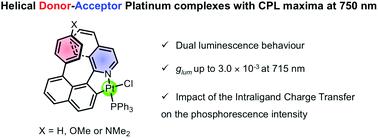当前位置:
X-MOL 学术
›
Dalton Trans.
›
论文详情
Our official English website, www.x-mol.net, welcomes your
feedback! (Note: you will need to create a separate account there.)
Helical donor–acceptor platinum complexes displaying dual luminescence and near-infrared circularly polarized luminescence
Dalton Transactions ( IF 3.5 ) Pub Date : 2021-09-13 , DOI: 10.1039/d1dt02184b Pablo Vázquez-Domínguez 1 , Océane Journaud 2 , Nicolas Vanthuyne 3 , Denis Jacquemin 4 , Ludovic Favereau 2 , Jeanne Crassous 2 , Abel Ros 1
Dalton Transactions ( IF 3.5 ) Pub Date : 2021-09-13 , DOI: 10.1039/d1dt02184b Pablo Vázquez-Domínguez 1 , Océane Journaud 2 , Nicolas Vanthuyne 3 , Denis Jacquemin 4 , Ludovic Favereau 2 , Jeanne Crassous 2 , Abel Ros 1
Affiliation

|
A series of chiral platina[5]helicenes displaying dual luminescence, i.e., fluorescence between 450 and 600 nm and red/NIR phosphorescence between 700 and 900 nm, has been synthesised, characterised and studied by first-principle calculations. This unusual behavior has been attributed to limited electronic interactions between the d orbitals of the metal and the π-orbitals of the organic ligand on the excited-state. Accordingly, the electron richness of the donor group on the helical ligand does not affect the energy of the phosphorescence process but does play a role on its efficiency. Interestingly, near-infrared circularly polarized luminescence can be obtained for the three complexes with dissymmetry factors up to 3 × 10−3 at 750 nm.
中文翻译:

螺旋供体-受体铂配合物显示双发光和近红外圆偏振发光
通过第一性原理计算合成、表征和研究了一系列显示双发光的手性铂[5]螺旋烯,即450和600 nm之间的荧光和700和900 nm之间的红色/NIR磷光。这种不寻常的行为归因于金属的 d 轨道与激发态有机配体的 π 轨道之间的有限电子相互作用。因此,螺旋配体上供体基团的电子丰富度不会影响磷光过程的能量,但确实对其效率起作用。有趣的是,在 750 nm 处,不对称因子高达 3 × 10 -3的三种配合物可以获得近红外圆偏振发光。
更新日期:2021-09-17
中文翻译:

螺旋供体-受体铂配合物显示双发光和近红外圆偏振发光
通过第一性原理计算合成、表征和研究了一系列显示双发光的手性铂[5]螺旋烯,即450和600 nm之间的荧光和700和900 nm之间的红色/NIR磷光。这种不寻常的行为归因于金属的 d 轨道与激发态有机配体的 π 轨道之间的有限电子相互作用。因此,螺旋配体上供体基团的电子丰富度不会影响磷光过程的能量,但确实对其效率起作用。有趣的是,在 750 nm 处,不对称因子高达 3 × 10 -3的三种配合物可以获得近红外圆偏振发光。









































 京公网安备 11010802027423号
京公网安备 11010802027423号